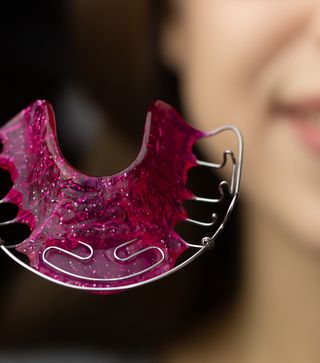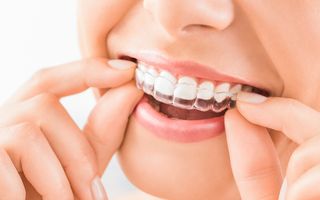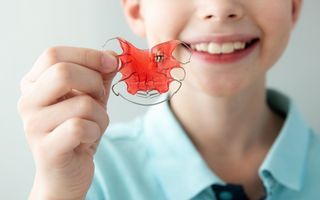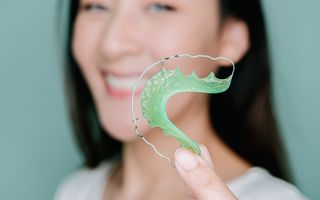Post-Orthodontics Corrections | What Happens If You Stop Wearing Your Retainer?

While we may have the best intentions when it comes to wearing our retainers after orthodontic treatment, it can be all too easy to slip out of the habit. Wearing a retainer is a crucial part of the orthodontic journey, ensuring that the results of your treatment are maintained over time. If this is the case for you, there’s a chance you’ll have started to notice that your teeth aren’t as straight as they once were.
However, there’s no need to despair—thanks to innovative teeth-straightening treatments like Invisalign®, you could get your beautifully straight smile back again without any hassle. Wearing a retainer is essential for maintaining a perfect smile, ensuring that your teeth stay in their new positions.
The importance of wearing a retainer
Wearing a retainer is a crucial part of the orthodontic treatment process. After wearing braces, your teeth have been moved into their new positions, but they are still susceptible to shifting.
A retainer helps to hold your teeth in place, allowing your gums and bones to settle and adjust to their new positions. Without a retainer, your teeth may shift back to their original positions, undoing the progress made during orthodontic treatment.
Types of retainers
There are two main types of retainers: fixed and removable. Fixed retainers are permanently attached to the back of your teeth and cannot be removed.
Removable retainers, on the other hand, can be taken out and replaced.

Removable retainers come in various styles, including Hawley retainers, Essix retainers, Vivera retainers, and clear retainers. Your orthodontist will recommend the best type of retainer for your specific needs.
What happens if you stop wearing your retainer?
While the orthodontic treatment you underwent did most of the work to gradually move your teeth into a better position, the process doesn’t end there.
After orthodontic treatment, your retainer plays a crucial role in keeping your teeth set in their new positions. Teeth naturally shift over time, and without a retainer, they may begin to move back toward their original positions, a phenomenon known as teeth shifting. Wearing a retainer is crucial for maintaining straight teeth.
What should I do if I stopped wearing my retainer?
If you’re concerned about your teeth not being as straight as they were previously due to not wearing your retainer, the first step is to book an appointment with your local dentist for an assessment.
In many cases, you’ll be able to undergo Invisalign® treatment, which uses clear aligners to move your teeth back into position. As Invisalign® is virtually invisible - as well as being a comfortable and faster-acting treatment compared to traditional metal braces - it’s a discreet, convenient and effective solution for achieving your perfect smile.
As everyone’s teeth are unique, your dentist will advise you on the best treatment option to bring your smile back into line.
Effects of not wearing your retainer after braces: teeth shifting
If you haven’t worn your retainer in months, you may have already noticed some discomfort or movement in your teeth.

Not wearing a retainer can undermine the results of previous orthodontic treatment, causing your teeth to shift back to their original positions. Some people experience retainer pain after not wearing it for a while, which is a sign that their teeth have shifted. If this happens, try wearing your retainer again—if it fits but feels tight, continue wearing it as directed. If it no longer fits, you may need a new retainer or even additional orthodontic treatment.
Retainers retain teeth in their new positions by exerting pressure to prevent them from shifting back. If you have stopped wearing your retainer for a month or longer, you risk more noticeable shifting. The longer you go without wearing your retainer, the more likely it is that your teeth will move significantly.
Causes of tooth movement
Tooth movement can occur due to a variety of factors, including the natural aging process, bad habits such as grinding or nail biting, and everyday wear and tear. As we age, our teeth naturally move forward in the mouth, and the lower set of teeth tend to narrow.
This can cause crowding and other orthodontic issues. Additionally, habits such as grinding or nail biting can put pressure on the teeth, causing them to shift.
What should I do if I stopped wearing My retainer?
If your teeth have moved because you haven’t been wearing your retainer, the first step is to schedule an appointment with your dentist for an assessment. After braces are removed, wearing a retainer is crucial to maintain the results.
If your teeth have shifted, you may need to restart orthodontic treatment, such as Invisalign®, to correct the misalignment. Invisalign® uses clear aligners to gently move your teeth back into place, and the treatment is often faster and more comfortable than traditional braces. If the retainer no longer fits, a new retainer may be needed.
How long will Invisalign® take to straighten my teeth?
Invisalign® takes between six and eighteen months to straighten your teeth. However, if your teeth haven’t moved entirely back to their original positions following your previous orthodontic treatment, it may take less time for this round of orthodontics to work.
When can I stop wearing my retainer?
One of the most common questions after orthodontic treatment is, “When can I stop wearing my retainers?” While the answer varies from person to person, most dentists and orthodontists recommend wearing them full-time for the first six months after treatment, followed by nighttime wear indefinitely.

If you’re wondering, “Can I stop wearing my retainer after two years?”, the answer depends on your teeth’s stability. Some people may need to wear a retainer forever to prevent teeth from shifting. Retainers are essential for maintaining teeth straight, ensuring they do not relapse into their original positions.
Preventing orthodontic relapse
Orthodontic relapse occurs when teeth shift back to their original positions after orthodontic treatment.
To prevent relapse, it’s essential to wear your retainer consistently, as directed by your orthodontist. Failure to wear a retainer can lead to a regression of the bite and a loss of the smile achieved through orthodontic treatment.
By wearing your retainer regularly, you can maintain your newly straightened teeth and prevent orthodontic relapse.
Maintaining your retainer
To keep your retainer in good condition, it’s essential to clean it regularly and store it properly. Clean your retainer with a soft-bristled brush and mild soap, and rinse it with warm water.
Avoid exposing your retainer to hot temperatures or chewing on it, as this can cause damage. Store your retainer in a protective case when not in use to prevent loss or damage.
How often should I wear my retainer?
After completing orthodontic treatment, most people are advised to wear their retainers nightly for life to maintain alignment. Wearing your retainers consistently is crucial to ensure your teeth remain straight. However, your dentist may adjust this schedule based on your individual needs.
If you experience pain when wearing your retainer again after a break, this may indicate that your teeth have shifted slightly. Wearing it consistently should help, but if discomfort persists, consult your dentist to see if an adjustment is needed.
Will I still need to wear a retainer after my Invisalign® treatment?
Yes, retainers are essential even after Invisalign®. The duration and frequency of wear depend on your teeth’s stability, but most people will need to wear a retainer indefinitely at night to keep their teeth in position. Retainers help prevent teeth shifting after Invisalign treatment.
While retainers are the best way to maintain alignment, there are some additional steps you can take to help prevent unwanted movement.
How to stop teeth from moving without a retainer:
- Keep up with oral hygiene by brushing twice a day and flossing daily.
- Remove your retainer before drinking hot beverages to prevent warping.
- Don’t use your last set of Invisalign aligners as a substitute—they are not designed for long-term wear.
- Maintain good oral health: Healthy gums and strong teeth are less likely to shift.
- Avoid excessive pressure on teeth: Habits like grinding or clenching can contribute to movement.
- Monitor any shifts: If you notice any changes in alignment, consult your dentist immediately.
However, the best way to prevent teeth from shifting back to their original positions is to wear retainers, especially at night, as advised by your orthodontist.
Learn more information about Invisalign® or orthodontic teeth straightening.

